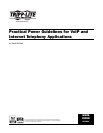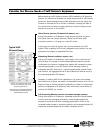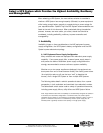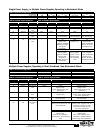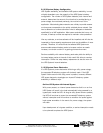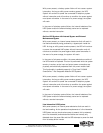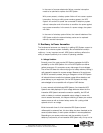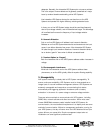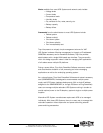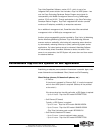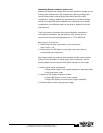
3
© 2008 TRIPP LITE. ALL RIGHTS RESERVED. THE POLICY OF TRIPP LITE IS ONE OF CONTINUOUS IMPROVEMENT.
SPECIFICATIONS ARE SUBJECT TO CHANGE WITHOUT NOTICE.
ALL TRADEMARKS ARE THE PROPERTY OF THEIR RESPECTIVE OWNERS.
Consider the Diverse Needs of VoIP Network Equipment
Before selecting a UPS System to ensure 100% availability of IP telephony
systems, it's important to consider the unique requirements of VoIP network
equipment. Network designs hosting VoIP applications will vary widely from
business to business due to a number of variables, including the scale of
the network and the variety of legacy equipment involved. However, three
devices are common to all networks:
Client Devices (phones, PC-based soft phones, etc.)
During the transition to IP telephony, these devices will either (a) derive
their power from the network cable via a Power over Ethernet (PoE)
connection scheme, or (b) plug into a local AC source.
If they plug into a local AC source, they must be protected by a UPS
System. Often a desktop UPS not only safeguards phone service, but also
guarantees file integrity for associated PC users.
Networking Devices (switches, routers, etc.)
During the transition to IP telephony, port capacity on the network and in
wiring closets will increase to accommodate additional devices (phones)
connected to the network. Increased port capacity will increase the power
requirements placed on your UPS System, either reducing runtime or
overloading the UPS. Note that if a networking device also supplies Power
over Ethernet, the aggregate load of all client devices will also be borne by
the networking device's UPS System.
Generally, an existing UPS will be inadequate to (a) power the increased
load [watts] and (b) power the load for an acceptable length of time. Five to
fifteen minutes of runtime provided to gracefully shut down the typical data
network is inadequate for IP telephony users who expect phone service to
continue for HOURS, not minutes.
Call Processing Devices (servers and related storage systems)
During the transition to IP telephony, dedicated servers are typically added
to drive voice and messaging applications, while storage systems are
required for voicemail and other messaging applications. Similar to the
increased burden placed on networking devices, call processing devices will
experience increased loads and will require increased runtime.
Typical VoIP
Network Design
Source: Cisco Systems white paper
“Power and Cooling for VoIP and IP
Telephony Applications”.
http://www.cisco.com/application/pdf/en/
us/guest/netsol/ns412/c654/cdccont_
0900aecd801a2c5f.pdf



